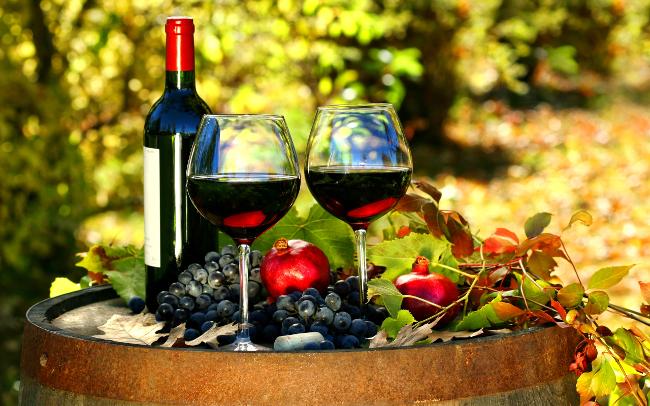Why You Should You Store Wine in a Wine Fridge and What Features to Look for When Buying One

If you are passionate about wine, then you must store it correctly. Due to various chemical reactions, all wine will eventually go off, this is accelerated by storing it at the wrong temperature, the wrong humidity or worse still, the wrong temperature and the wrong humidity - to delay this you must store your wine correctly. After all, it doesn't matter if you have spent a few pounds on a bottle of wine, or thousands of pounds, you do not want to store it, only to find that when you come to drink it, it has gone off. Storing it correctly will ensure that your wine will last longer.
We have all seen grand country houses with wine cellars where the wine can be stored correctly at the right temperature and humidity. Unfortunately, in this day and age, not many of us have such facilities - this is where the wine fridge steps in. The wine fridge stores the wine at the correct temperature and humidity until you are ready to enjoy it. This is vital if you are storing it for personal consumption at a later date, or if you plan to store it as an investment - the right wine fridge will replicate the temperature and the humidity of a traditional wine cellar. Wine fridges range from counter top fridges that contain a small number of bottles which can be positioned virtually anywhere, fridges intended to be integrated into your kitchen, through to large free standing fridges intended to store many bottles for the serious wine connoisseur or a hotel or restaurant.Wine fridges are specifically designed to help you to store your wine correctly and mimic the conditions of a cool damp cellar.
So, I hear you say, "can't I just store my wine in my domestic fridge?" No! Your normal domestic fridge has three main problems with it. Firstly it is too cold to store your wine at for any time more than about a week, meaning that it will go off quicker. Secondly, the humidity is incorrect and changes considerably depending on what is in your fridge and how you use it. This is not such a problem with wines with screw-tops, however this can massively influence how effective a cork is at stopping air from getting to your wine. Thirdly, you store many other items in your fridge with strong smells and flavours which may contaminate your wine. So, only if you have no alternative, should you use your domestic fridge to store your wine, and then only for a small time. "Ok, so what about my beer fridge?" No! Beer fridges have become massively popular over the last few years. However, these are generally just small versions of your domestic fridge - that is they are too cold. They do have the advantage that strong flavoured and smelling foods are not generally stored in them, however they do not generally have racks inside them to ensure that wines can correctly be stored on their side and do not control humidity. So, better than a domestic fridge? Arguably. As good a place to store your wine as a wine fridge? Certainly not! Know more https://www.lovecraftwines.com/large-wine-fridges/
So, once you have decided to safeguard your wine and store it correctly the next obvious question is "what features should I look for when buying a fridge?." This can potentially be a confusing topic, so let's discuss the features that you may want to consider when deciding what fridge to buy. What features your wine fridge has will determine how effective it is at storing your wine, as well as how easy it is to live with on a day to day basis. Choose the wrong fridge and you could very soon regret your decision. Choose the right fridge and you could have many happy years of use. The following is not an exhaustive list but contains some of the things that you may want to consider when choosing your fridge.
- Free standing, integrated, or counter top- Where do you plan to put your fridge? There are basically three types of fridge out there, free standing, integrated (sometimes called 'built-in'), or counter top. Free standing fridges can be easily positioned in any available space or used to proudly display your wine in the middle of your lounge or restaurant. Built in fridges form an integral part of your kitchen, and as such your kitchen would need to be modified or designed accordingly. Finally, the counter top fridge is a simple addition to you existing space and can be added virtually anywhere.
- Lock- Where are you planning to have your fridge? Do you need to restrict access in any way? On a domestic fridge this may be to keep young children from accessing your wine. In a commercial fridge this may be to restrict access, if for example, your fridge is in the middle of a busy restaurant. In addition to this, by restricting the amount that the fridge is opened, the temperature and humidity in the fridge will not fluctuate as much.
- Multiple temperature zones- Are you planning to store different types of wines in your fridge, or plan to serve wine straight from your fridge - this may require different temperatures. By having a fridge with different zones you have a lot more flexibility in the way that you use it, and may be able to get away with not using a Wine Cooler.
- Anti-vibration- Some fridges that are out there have 'anti-vibration' cooling systems. Consider how much your domestic fridge vibrates each time the compressor starts up, these vibrations will unsettle the sediment in your wine. By having an anti-vibration feature in your fridge your wine will remain undisturbed.
- Temperature range and adjustment- Different wines need to be stored and served at different temperatures. By having adjustment available to you, you can set your fridge accordingly. Note that wine fridges can cool, OR HEAT your wine to the perfect temperature.
- Noise- Where do you plan to put your fridge? There is a big difference in the noise generated by some fridges. If you are planning to put your fridge in a utility room then this is not a problem. However, if you are putting your fridge next to your dining room table it may be!
How to Choose the Right Wine Fridge

Buying a wine fridge is a relatively large investment, and you need to get it right the first time. I have seen too many people buy poorly, ultimately becoming disappointed and frustrated with their cabinet, something that can easily be avoided.
When selecting the wine fridge that best suits your needs, consider the following 4 key factors:
1. Capacity - from 12 bottles to over 470
Determine how many bottles you need to store now and consider how your wine collection may grow in the future. In my experience, many wine collectors buy more wine once they find a wine storage solution, so buy a larger cabinet than you think you initially need. If your budget is limited, invest in a larger size wine cabinet before opting for all the bells and whistles such as extra sliding shelves and glass door.
2. Location - on display within the home/office or in the garage
If you intend to put your wine fridge in the dining room, living area, or on display, consider customising with a glass door or a choice of colours and finishes (including leather and stainless steel). Another option is to build the wine cabinet into kitchen cabinetry or a furniture piece. In this case, ensure that the cabinet is front ventilated or that there is some room left for air circulation otherwise the wine cabinet will not perform properly. Another factor you need to consider if the cabinet is in the home is the amount of noise it will make.
If the wine cabinet is going in the garage, my guess is that aesthetics may not be as important so you can save money by opting for a solid door. If you have a lot of wine that you want to store longer term, storage shelves allow higher capacity and further savings.
3. Temperature zones - single, two, three or multiple temperature
Determine how much of your wine needs to be stored longer term versus how much wine you need 'at call' for short term drinking. ALL wine should be stored at 14 degrees Celsius with a temperature variation of no more than one degree, whilst drinking temperature varies between 6 degrees Celsius (eg. for champagne) and 18 degrees Celsius (eg. for big reds), depending on wine variety.
Single temperature wine cabinets are best suited to storing wine longer term, whilst 2, 3 and multi temperature units are ideal for restaurants or those who entertain quite regularly and therefore generally require a large amount of wine 'at call' at ideal drinking temperature.
4. Shelving - roller mounted, sliding, storage or different bottle sizes
When it comes to the day to day use and functionality of your wine cabinet (and, believe me, the amount of enjoyment versus frustration you will experience), an important factor is the type of shelving.
Firstly, unless the shelves are roller mounted, you will probably struggle to open a fully stacked shelf. Secondly, the style of shelving (ie. either sliding or storage) needed is based on how much of the same wine you buy as well as how long your wine needs to be aged. If you typically buy wine in dozens or half dozens and want to store longer term, you may consider storage shelves which allow greater capacity in your wine cabinet as bottles are stacked on top of each other. Sliding shelves are ideal for wines you want to drink shorter term as they allow easy access to each bottle. Last but by no means least, consider buying shelves that are specifically made for different wine varieties such as champagne and Bordeaux.
Taking all of this into consideration, here is a list of questions you should ask the organisation you are buying your wine cabinet from:
Questions to Ask When Researching a Wine Fridge
1. Where was the wine fridge manufactured and how long has the manufacturer been making wine cabinets?
2. Can I see the wine fridge fully stacked with wine so I can understand capacity as well as functionality for different bottle shapes?
3. How does the wine cabinet's shelving cater for different bottle shapes and sizes (eg. champagne)?
4. Can I slide a shelf that is fully stacked so I can see how easy it is to use?
5. Can I hear the wine fridge turned on so I can determine how much noise it makes?
6. How does the light in the wine cabinet impact the wine? Is it a 'cold' light, or does it heat up?
7. Is humidity displayed and monitored and how does it ensure that corks don't dry out?
8. Is there more than one degree variance once the temperature is set at the recommended 14 degrees?
9. Is your organisation responsible for after sales service or will you pass me on to the manufacturer?
10. How precisely does the unit deliver and monitor uniform temperature throughout the unit?
11. How does the wine cabinet address vibration (which is a major enemy of wine long term)?
12. Are the walls stipled aluminum or just plastic?
13. Does the organisation understand storing and aging wine? Can they add some value?